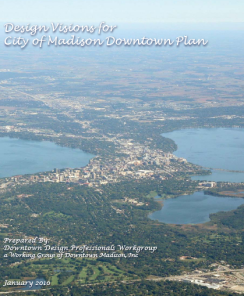I recently wrote about the work of a group of design professionals to create visions for making downtown Madison more vibrant and sustainable. Their work was recognized by the Wisconsin Chapter of the American Planning Association (WAPA). WAPA presented the design group a special award (meaning they don’t conveniently fit the prescribed categories) for their design service. Congratulations design professionals!
The pdf (8mb) of their report, Design Visions for City of Madison Downtown Plan, can be downloaded here.
This post highlights the full block development concept for Mifflin Street. The design professionals observed that Mifflin Street, from the Library to North Shore Drive is a “hole in the donut.” Meaning the areas all around it are transitioning to a built environment more like the central urban core: greater density, mix of uses, infill and renovations. But Mifflin Street remains largely student housing in converted frame buildings, many in poor shape.
This hole in the donut observation prompted the designers to create visions for full-block redevelopments: “a densely built mixed-use neighborhood that preserves and enhances the social fabric of ‘Miffland’.”
One full block redevelopment calls for adding four- and three-story mixed-use buildings at the ends of the block, retaining traditional 2-story houses in the center portion of the blocks and creating shared public space in the center of the block. Quoting from the report:
“The premise for this Mifflin block design is that there are many existing structures that contribute to the historical context and human scale of the street that should be preserved to create a core at the center of the block. Th ese existing vernacular structures form a “nucleus for social interaction” identified as the Miffland Forum Park.
 “New housing is part of new infi ll buildings that gradually gain in size as they progress towards the perimeter streets, Bedford and Bassett. This organization avoids hemming in the smaller residential structures. Th e rooftops of these large buildings can include green plateaus, plazas and gardens to create architectural diversity and avoid the “flat-topping” eff ect that is prevalent today. Varying building setbacks can also create nodes and pocket parks for social interaction.
“New housing is part of new infi ll buildings that gradually gain in size as they progress towards the perimeter streets, Bedford and Bassett. This organization avoids hemming in the smaller residential structures. Th e rooftops of these large buildings can include green plateaus, plazas and gardens to create architectural diversity and avoid the “flat-topping” eff ect that is prevalent today. Varying building setbacks can also create nodes and pocket parks for social interaction.
“The block is served by two main auto access points, leading to lower level parking (with a plaza cover) and enclosed parking as part of the larger buildings. In this way, service access and driveways can be consolidated for collective effi ciency and to create connective green space.
“Sustainable design is a core value of the neighborhood and is manifested in a mix of carbon-neutral, single-family and
multifamily buildings and landscaping that is part of individual buildings and public streetscaping. Green space, green roofs, rain gardens, solar access, and shared services all enhance the community, respect for our resources and spring from the progressive Miffl in neighborhood tradition.”



